 Seize the Day With the Samsung Intrepid from Sprint
Seize the Day With the Samsung Intrepid from Sprint
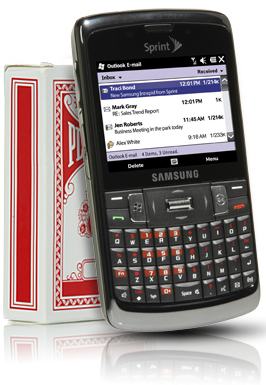
Product Category: PDA PhoneWhere to Buy: SprintPrice: $449.99 USD; $149.99 with a new or upgrade 2 year contract Pros: - Great keyboard;
- Design provides a good balance of features for business and pleasure;
- Auto focus feature on camera.
Cons: - Windows Mobile 6.5 provides limited touch friendly control;
- Stylus is very hard to remove;
- Slow auto focus.
Summary: Windows Mobile 6.5 has hit the marketplace in a big way and phones featuring it are widely available from all of the major US providers. Among its offerings, Sprint features the Samsung Intrepid, a Windows Mobile phone in the classic BlackBerry-style form factor. The Intrepid distinguishes itself in that it's based on Windows Mobile 6.5 Professional, which adds a touch screen featured on only a small handful of devices of this style currently available from US carriers and not offered on BlackBerrys. So let's see if the combination of touchscreen and QWERTY keyboard puts the Intrepid at or near the top of the "must have" list. A Familiar Design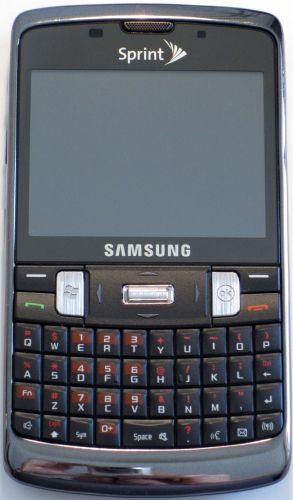
Figure 1: Looks like a BlackBerry, but it's all Samsung. The Intrepid's overall design doesn't break any new ground... it's on a par with similar designs that have preceded it. That's not a criticism, since this type of design has been very popular because it works well for its intended purpose. The controls of the Intrepid are dominated by two large brushed metal buttons, the OK key and the Windows key. These keys are required for WM 6.5 Pro devices. Directional control is provided by a four-way pad with the Enter key in the center. A Talk key, an End key, two softkeys and of course the QWERTY keypad round out the controls on the front of the Intrepid. 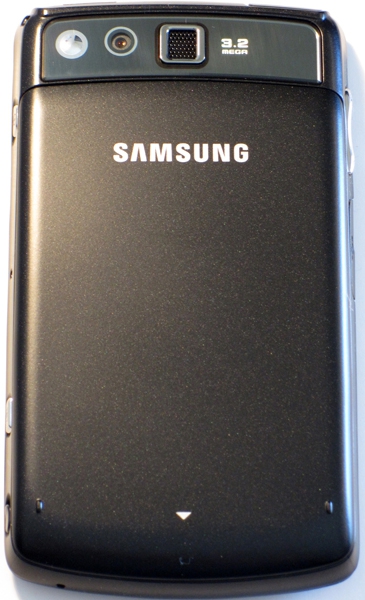
Figure 2: Standard issue "Smartphone back". The back of the Intrepid is what you'd expect, with the lens for the 3.2 mp camera, a mirror and external speaker. 
Figure 3: No proprietary headphone jack for the Intrepid... way to go, Samsung! Not much is on the top, but music fans will be happy to note that Samsung has provided a standard 3.5 inch headphone jack, tucked behind a flap on the top right. HTC, please take note. 
Figure 4: At least the stylus won't fall out and get lost... The right side features the power button, access to the reset button, the camera button and the stylus. The most notable item on this side is the stylus, which is without a doubt the most difficult to remove stylus I've ever encountered. Have your manicurist on speed dial, because this thing could break more nails than a soda can. 
Figure 5: Just the necessities on the bottom... Nothing but the microphone on the bottom. 
Figure 6: A clean look with the sync cable connector covered. The left side contains the charger/sync cable connector behind a flap and the volume control. Hope the flap doesn't break off like the one on my original Blackjack. 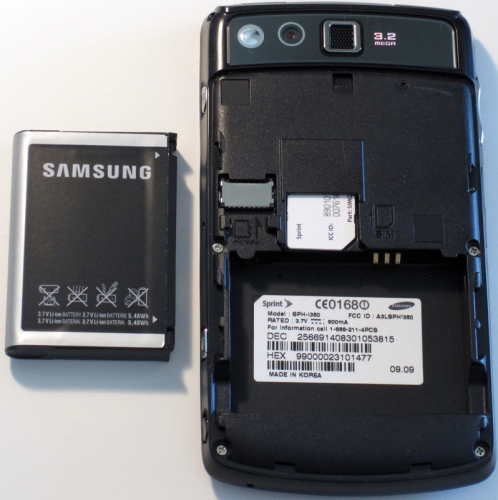
Figure 7: Storage cards in the battery compartment... not my favorite design trend. With the back cover removed, you can see the battery compartment and the slot for a microSD card. While it's hardly a deal killer, I don't like the fact that not only do you have to remove the battery cover to access the microSD card, but the battery, too, which requires the phone to reset. You might be surprised to see a SIM card in a phone designed for Sprint's CDMA network. The reason for this is that the Intrepid is designated as a world phone and is designed to work with the GSM networks that are commonly used outside the US. A few comments on the hardware design. First, although the Intrepid seems sturdy enough, the keys on the keyboard have a rather hollow feel, which feels a bit cheap compared to most Blackberrys and even the Samsung Jack. The keyboard functions just fine, however, and its larger size as compared to the Jack keeps keying errors to a minimum. Second, the directional keypad is large and easy to use. However, a directional keypad is starting to seem somewhat outdated when considering that Blackberrys have offered trackballs for some time and RIM is in the process of replacing those with optical trackpads. At any rate, even though the keypad isn't as flashy and high tech as an optical trackpad, it still gets the job done just fine. The labels for the softkeys are located above the Windows and OK keys, with the actual hardware softkeys to the left and right of the labels, respectively. In the time I was using the Intrepid, I never completely got past the tendency to hit the Windows and OK keys when I meant to hit the softkeys. And I did get into the habit of using the softkeys in place of the onscreen equivalents since the latter were sometimes a bit unresponsive... you really have to hit them perfectly for them to work. As I stated above, it can be a real struggle to remove the stylus. Unfortunately, the combination of a small screen with a resistive screen design and limits to the finger-friendly controls of this initial release of WM 6.5 result in the need to use the stylus more often than many of us would like. Once the stylus is removed, it's fine to work with, since it measures around four inches when fully expanded. 
Figure 8: Comparing the Intrepid to other popular phones with the same form factor... and to the ubiquitous iPhone. To give you an idea of the size of the Intrepid, I've provided a chart with specs for some other comparable phones. It includes the Blackberry Curve 8530, the current Blackberry that's the most comparable; the Samsung Jack, a Windows Mobile Standard (non-touchscreen) with a similar overall design; and the iPhone, to which every smartphone is ultimately compared these days. Both the Curve and the Jack are slightly smaller than the Intrepid, which ends up being very close in size to the iPhone, albeit .38 inches shorter and .9 oz lighter. In fact, although the Intrepid is among the larger phones of those I've listed, it seems amazingly light for its size. The Intrepid, Jack and Curve all sport landscape screens sized at about 2.5 inches, with 320 x 240 (QVGA) and 65,000 colors. While this has been a standard screen resolution over a number of years, it's now drifted down towards the bottom of the resolution scale as phones with very high resolution screens (such as the Nexus One with 800 x 600 resolution) are becoming widely available. Blackberry is now featuring phones in this style with much higher resolution screens, such as the Bold 9700 with its 2.4 inch, 640 x 360 screen, so they're raising the bar for screen standards for this type of phone.
The InterfaceWindows Mobile 6.5 Professional is a big departure from the classic Pocket PC look that was introduced 10 years ago. The Today screen in particular represents an attempt to make WM devices more competitive with the iPhone and other touch friendly devices that have reshaped the smartphone market over the past couple of years. Yet, as a point release (from 6.1), it's recognized as a step in that direction to try to remain competitive until the transition to the reportedly heavily redesigned Windows Mobile 7 begins later this year. 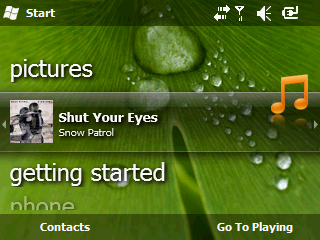
Figure 9: Media Player control from the Today screen. 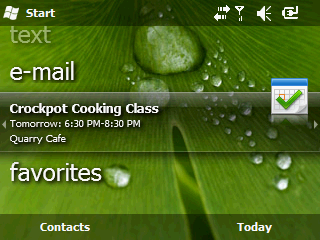
Figure 10: Access your calendar without opening the app. The new default Today screen is similar in appearance to the screen on Microsoft's latest Zune players. A series of information categories (Music, Pictures, Phone, etc.) appear along the left edge of the screen. You scroll through these categories with a highlight bar. When the highlight bar rests on a category, details about that category are displayed. For example, the Phone category will display information about missed calls and the Music category will display selections from a currently playing album. Pressing the Enter button calls up more category related functions. While the Music category is highlighted, the Enter button will play or pause the currently displayed song. By default, the left softkey is set to bring up the Contacts app, while the right softkey is context sensitive by the currently displayed category. When Music is highlighted, the right key will launch Windows Media Player. 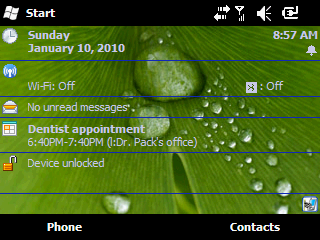
Figure 11: And for those of us averse to change, the Classic style. For those of you who like the way things were in the past, the Intrepid can be set with a "classic" Today screen. The classic screens let you pick and choose among items to appear on the screen, while the new style screen provides default items which can't be changed, although the Getting Started item can be removed when you're done with it. 
Figure 12: The new Start Menu has more style than the Program listing it replaces. The new Start menu is another major departure from past versions of Windows Mobile. In the past, the Start menu was a drop down menu that functioned in a similar fashion to the Start menu that you find on desktop versions of Windows. The new Start menu is a page of diagonally arranged icons for applications and settings. A spotlight style highlight indicates the currently chosen icon. With the Intrepid, you can use your finger to scroll through the icons or move through them using the directional keypad. The Start menu now resembles the multiple pages of icons that comprise the iPhone's primary interface, though the WM version scrolls vertically and doesn't actually have "pages". 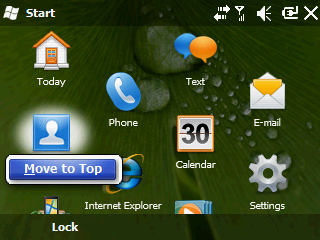
Figure 13: Limited customization on the icon page... not an iPhone characteristic that I would have chosen to emulate... The Start menu provides limited customization... all you can do is to move an icon to the top of the screen. Since most of the key applications (Phone, Calendar, E-Mail, Messaging, etc.) can be accessed from the Today page, the Start menu is available to access less frequently used applications. For those of you who have used a smartphone running Windows Mobile Standard 6.x, a lot of what I just described may seem pretty familiar. In fact, the WM 6.5 Professional interface owes much of its design approach to the Standard version, with its sliding panel Today screen and icon based Start menu. As a result, although there is a 6.5 version of WM Standard, the changes are minimal as compared to the 6.1 version, while the 6.5 version of Professional is significantly changed from the previous version. I got quite proficient with WM Standard during the time that I used my Samsung Jack and I found it to suit me quite well. With the Intrepid, the vast majority of commands and keystrokes work much like WM Standard and I found myself using that approach in place of the touch screen much of the time.
Lukewarm Reception to WM 6.5 Professional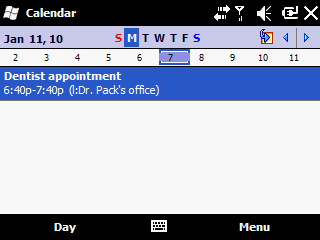
Figure 14: At first glance, the Calendar's Day view looks little changed. If you keep abreast of tech news, you're probably aware that WM 6.5 Professional got a pretty tepid reception from the press. While it was recognized as a step in the right direction, it was criticized as a flashy "coat of paint" over the previous version of Windows Mobile. Much of the reason for that is that Microsoft wasn't quite ready to abandon the resistive touch screen optimized for a stylus that's been the foundation for Windows Mobile touch screen devices for years. They also weren't quite ready to replace all of the applications bundled with the devices, and most of those applications are more stylus friendly than finger friendly. 
Figure 15: Large finger friendly menus are a step in the right direction. When you go into many of the bundled applications, you'll find that Microsoft has replaced the primary menu, which previously was a stylus friendly design, with a more finger friendly design. So you'll see larger items on the menu with scroll arrows on the top and bottom, all of which are easy to access with a finger. The Calendar app in Figure 15 shows the improved menu. 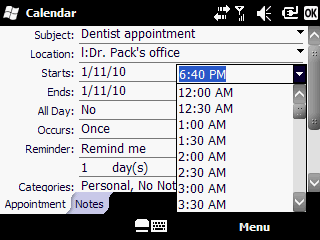
Figure 16: But older "stylus friendly" controls are also to be found. However, they weren't able to upgrade all of the onscreen controls for this version of WM. Once you get past the new primary menu, you'll encounter controls such as the time selector shown in Figure 16. The items are too small to reliably hit with a fingertip, so this control is much easier to use with a stylus. Keep in mind that using a stylus isn't your only option here. When you reach this control, you could key the time in directly with the keyboard or navigate the dropdown using the directional keypad. There are many other instances of similarly designed controls in the WM 6.5 apps, such as the day and week selectors shown near the top of Figure 14. As with the time selector, these controls are easily navigated with either the stylus or the directional pad. But the bottom line is that the experience falls somewhat short of the finger friendly environment so in demand these days in consumer devices. On the other hand, WM 6.5 maintains the platform's already strong business functionality (an area in which most seem to agree that it still remains ahead of consumer oriented devices like the iPhone) while adding finger friendliness, graphics embellishments and other consumer features for those who wish to or need to work AND play on a single device. WM's open architecture makes it much easier for developers to write complex applications as compared to the closed architecture of the iPhone. Features like developer access to the system databases and running tasks in the background are powerful tools available in WM and not with the iPhone. Things Will Only Get BetterIn fact, if you're looking for a better touch screen experience on WM devices, it appears that they already have gotten better. Right around the time during which I was writing this review, phones with an incremental upgrade to WM 6.5, tagged 6.5.3, made their debut at CES 2010. And while a point-point release doesn't sound like it would offer much, this one is far more substantial than you'd expect. New and upgraded features include: - An icon bar that expands by swiping the notification area at the top of the screen. It scrolls from side to side and adds large icons for searching, volume, battery, etc. that can access related functions (such as mute and power settings) in a finger friendly manner;
- Greatly expanded availability of finger friendly controls in bundled apps. For example, the linked video shows the improved design of the very same time selector that I highlighted in Figure 16. The new dropdown provides widely spaced choices that are easy to select with a finger, and it scrolls up and down easily;
- More finger friendly menus. In many apps, additional touch friendly menus have been added to ease access to a greater variety of commands;
- The Start menu allows icons to be moved around to any part of the screen, rather than just moved to the top of the screen as before;
- Multi-touch control is now available;
- A greatly improved onscreen keyboard, again very finger friendly.
More information is available on this site and on ZDNet. Press reviews of this update have stated that had this been the version of WM 6.5 that was released back in October, it would have been much more warmly received. Samsung has been pretty good about providing incremental upgrades on their WM devices (my Jack had WM 6.1 when I got it and they upgraded it to WM 6.5), so perhaps the Intrepid will get the benefit of this upgrade as well. Only the folks at Samsung can speak to this however.
Using the IntrepidOver the past few years, I've used a number of messenger style phones, among them a Samsung Blackjack, a Motorola Q9h and the Samsung Jack that I currently own, but the Intrepid's design is one I hadn't encountered before... a WM Professional device with a BlackBerry form factor, which gives it a touch screen that's found in only a small number of devices of this format currently available from US wireless providers. To a large degree, I found myself using the navigation pad and softkeys in lieu of the touch screen, probably because in that mode, the Intrepid works much like the Jack that I know and like very much. Another reason is that with the comparatively small touch screen, on screen controls are sometimes small and require the stylus to use them, unless a screen or application is designed to be finger friendly. As I discussed before, the Today screen and the primary menus of most applications have finger friendly designs, but secondary and settings screens retain their legacy stylus friendly designs. So you'll probably find yourself switching back and forth between the touch screen and the keyboard/directional pad/softkey modes of operation as different scenarios present themselves. The touch screen itself is among the better resistive screens, in that its responsiveness is much like that of a capacitive screen while still providing the precision that's the hallmark of the resistive screen. On the home screen, within the contact list, in web browsers, etc., the Intrepid scrolls fluidly in response to finger swipes. You do have to be careful not to use too much pressure with your finger swipes or they might be interpreted as pressing the screen, which may result in selecting something when you only wanted to scroll. But after a couple of days of using the Intrepid, I got used to the touch screen and inadvertent selections became much less common. Unlike other touch screen phones, the Intrepid doesn't include a large finger friendly onscreen keyboard because of the hardware keyboard (not to mention that such an onscreen keyboard would be impractical as it would nearly cover the whole screen). Aside from the slightly hollow feel of the keys, I like the keyboard a lot. Since the Intrepid is wider than the Jack, the keyboard is also slightly wider, and the improvement in typing accuracy is noticeable. The keys have a solid click and I like the matte finish on them... maybe it's my imagination, but the matte finish gives me a feeling of more solid connection with the keys when I type. The keyboard includes dedicated keys to bring up the Wireless Manager, Messaging (E-mail or Text Messaging) and to turn the speakerphone on and off during calls. Pressing and holding the Space key will put the phone in and out of Silent mode. There's also a dedicated key for TellMe, an application for voice dialing and other voice controlled activities. Overall, I consider the keyboard to be one of the Intrepid's most well designed features. With the Intrepid's fine keyboard, there's little reason to consider using alternate input methods, but it includes the classic Block Recognizer, Letter Recognizer, QWERTY keyboard (for stylus use), Symbol Selector and Transcriber. Some people may prefer one or more of these stylus based input methods... Transcriber (handwriting recognition) in particular can be useful under some conditions. The control keys and directional keypad above the keyboard all share the solid click action of the keyboard itself. And other than the brushed metal OK, Start and Enter keys, they all have the pleasant matte surface. The metal keys work fine and they can serve as guides to orient your fingers to use those keys without looking at them. 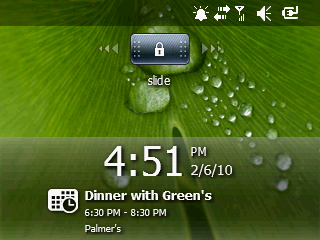
Figure 17: "Slide to unlock" controls are all the rage... The Lock screen is MS' take on the iPhone's "slide to unlock" control. While the iPhone's control slides to the right only, the Intrepid's is centered on the top of the screen when locked and you can slide it either way. A nice touch is that your next appointment is displayed even while the phone is locked. Making and Receiving CallsTo test the sound quality of the Intrepid, I did a few comparisons with my current work phone, a BlackBerry Bold 9700. In reviews, the 9700 has been judged as one of the best sounding phones currently available. First I called my number at work using each phone as a handset and let the call go to voice mail. The greeting sounded very clear on both phones. I also recorded a message with both phones. Then I tried the same test using the speakerphone on each phone. While listening to the greeting, the 9700 was clear and just slightly tinny. The Intrepid broke up a bit while playing the greeting and it sounded more tinny than the 9700. I then checked my voice mail and the calls made with the handsets sounded great with both phones. The call made with the 9700's speakerphone was indistinguishable from the call made with the handset, while the Intrepid's sounded a bit tinny by comparison. Finally, I engaged the help of a friend and made calls between the two phones. When using the handsets, both listening and talking quality was essentially a tie. When using the speakerphones, the 9700 once again outperformed the Intrepid when listening, with a fuller, less tinny sound. The Intrepid was still acceptable, just not up to the level of the 9700. Speaking through the speakerphone was much the same, with the Intrepid giving an acceptable but more tinny sounding performance as compared to the 9700. Overall, I'd rate both phones as above average in handset performance. As speakerphones, the 9700 would still be rated above average, while the Intrepid would drop down a notch to average. 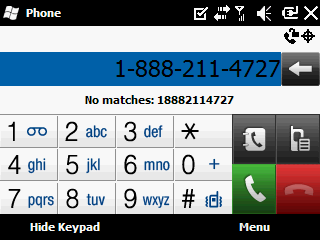
Figure 18: Your fingers will find this dialing screen very friendly... As far as controls are concerned, this is where the Intrepid's touch screen is used to its greatest advantage. Dialing is simple enough on both phones with the numeric keypad present in the keyboard. But the Intrepid offers a phone keypad on its touch screen as well. Even though the screen itself is small, the keys on the keypad are large enough to be easily used with your fingers. 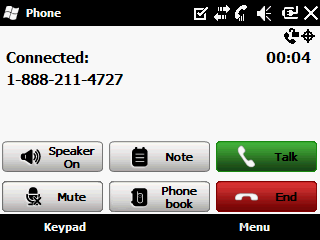
Figure 19: All the necessary controls to manage a connected call. After connecting, the Intrepid's onscreen controls for mute and speaker are very convenient. Both the 9700 and the Intrepid can access these functions through a menu, but that's the only option for the 9700. Given both options, I'd go with the touch screen.
Camera PerformanceIf you've read previous reviews of mine, you know that I'm not a huge fan of cameras built into cell phones. However, I do recognize their place in the world. I really don't want to get into another tiresome debate on this topic, so let me just sum it up like this... for everyday casual photographs under good lighting conditions, most cell phone cameras will do a satisfactory job. If you're planning for an occasion where you'd expect to get important keepsake photos (a wedding, graduation, sightseeing vacation, etc.), I would recommend that you plan ahead and use a dedicated digital camera with features such as an optical zoom lens, "real" flash, image stabilization, extensive built-in exposure algorithms, etc., features not currently available on even the most advanced cell phone camera. I'm confident in saying that such a camera should give you better results under comparable circumstances. So, if "the best camera is the one you have with you" and that camera is the Samsung Intrepid, how would you do? Well, it's a mixed bag. The Intrepid has many of the features found in the most advanced cell phone cameras, with the most important feature being an auto focus lens. Not only is the auto focus lens likely to give you sharper photographs, but better exposures as well, since the "tricks" used by fixed focus cameras to ensure sharp photos are at the expense of exposure flexibility. Other features include: - Various shooting modes, such as Single, Continuous and Smile (the shutter fires when it detects a smiling face);
- Scene settings such as Sports, Party and Sunset;
- Self timer settings;
- Exposure compensation;
- White Balance.
One feature missing on the Intrepid is an LED flash, a feature available on some other phones. 
Figure 20: Automatic white balance struggled with tungsten lighting. I took a standard shot of a floral centerpiece with the Intrepid, leaving all of the settings on automatic. As you can see, the automatic white balance setting did only a fair job of compensating for the reddish cast of the tungsten lighting. 
Figure 21: Dark and reddish image on a cloudy day. An outdoor photo on a gloomy, cloudy day ended up reddish, which again indicates that the automatic white balance did only a fair job. I could have tried changing some of the automatic settings, but my sense is that the average user of such a camera would pretty much limit him or herself to the automatic settings. So under those conditions, what I got is probably what you'd get. To be fair, though, professional tests of even higher end digital cameras often result in a criticism of the performance of the automatic white balance. 
Figure 22: A good picture on a rare sunny day. An outdoor photo on a sunny day turned out better. The automatic white balance seemed to be much more effective under these conditions. Which are the optimal conditions for this type of camera. These photos would probably pass muster with the average person, but the biggest drawback of this particular camera was the speed of the auto focusing. Depending on lighting conditions, it took from two to four seconds from the time that I pressed the shutter button for the picture to be taken. From a photography standpoint, that's a near eternity and can result in photo opportunities being missed. By comparison, my Canon SD970 took comparable photos in under one second. While other autofocus cell phone cameras were slower than the Canon, they were generally much faster than the Intrepid. In my eyes, this makes the Intrepid a less than ideal choice for a general purpose camera.
Web BrowsingWM 6.5 includes the latest touch enabled version of Internet Explorer Mobile. In addition to the interface updates, it also includes much more contemporary underpinnings than did previous versions. 
Figure 23: Here's how the latest Internet Explorer Mobile looks on a larger touch screen. It looks similar on the Intrepid, just in landscape orientation. So, how well did the updates go? For starters, it looks pretty good. (Unfortunately, I can't include any screen shots because this phone and the software I use for my screenshots are at odds, so the data connection won't work with the software installed.) It uses a very nice semi-transparent toolbar that's less obtrusive than those of its competitors. It shrinks down to a single icon on the right of the screen when it's retrieving and displaying a page, and a tap on that icon expands to a full set of five icons. Taking a page from Opera Mobile, you scroll around a small version of a page and double-tap when you want to expand something. It does a good job of filling the screen with the content on which you've tapped, in particular filling the page with text and wrapping it to fit. My biggest issue with this version of IE Mobile is slow rendering. I don't know if it was the phone, the software or the network, but it seemed like I was waiting an eternity even with a 3G connection. And a partially displayed screen was mostly unresponsive, so you couldn't reliably specify that you wanted to zoom in on a particular part of the page until the page was almost fully rendered. 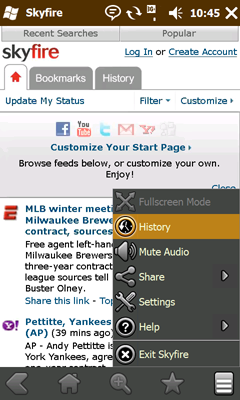
Figure 24: SkyFire on a larger screen. Again, the Intrepid looks similar in landscape. To try to narrow down the culprit, I installed SkyFire, the browser that I use on my Samsung Jack. It supports just about every flavor of Windows Mobile, including the Intrepid. I fired it up and BAM... it was like the Intrepid got a huge dose of adrenaline. Pages rendered quickly and I could navigate easily on partially rendered pages. When I tapped on a section of the page on which I wanted to zoom in on a partially rendered page, SkyFire would interrupt the initial page load and start to load the zoomed section. SkyFire is a proxy browser, which speeds things up by communicating with servers that retrieve, pre-render and compress the content that you've requested before it's sent to your phone. The difference is very noticeable when compared to the standard approach of IE Mobile, which retrieves content directly from the site that contains it. The touch screen is very responsive with both browsers, feeling almost like a capacitive screen rather than a resistive screen. Both browsers work nicely with the directional pad as well, if that's your preference. So it seems that the Intrepid is a great phone for browsing, as long as you have the right browser. Both SkyFire and Opera Mobile (another product using proxy servers for greater speed) work well, both are faster than IE Mobile by a considerable degree and both are free. So if you get an Intrepid, either of these alternative browsers should be one of your first additions.
SoftwareAs with all WM Pro phones, the Intrepid includes Office Mobile, which consists of mobile versions of Excel, OneNote, PowerPoint and Word. All but PowerPoint can create and edit documents synched from the desktop with minimal loss of formatting (only a problem with documents with very complex formatting). PowerPoint is a viewing tool only. Since the Intrepid includes a GPS, Sprint offers SprintNav, a navigation package with voice prompts that include street names. There's a trial version included with the Intrepid, but there's a monthly subscription fee for continued use (currently $9.99/month). Although not bundled, Google Maps can also be downloaded for free and works very nicely on the Intrepid. The GPS itself was impressively fast at acquiring satellites... after the first "cold" start, I'd typically have seven or more satellites in under five seconds. And the connection was strong... I never had any problems with losing satellite reception. Another interesting app bundled with the Intrepid is Microsoft's TellMe, which provides voice dialing, sending text messages created by voice, searching and more. If you're looking for the nearest coffee shop, activate TellMe and just say "coffee" and BING will come up with the closest ones based on your current location. It seems to work pretty well and the vocal responses sound much more natural than the old Voice Command. I also liked the SmartReader app. I've seen business card readers on other phones, apps that use the camera to take a picture of a business card and then use OCR to try to pick out the pertinent details. That's what SmartReader does, but it seems quite a bit more accurate than apps like this that I've seen previously. It can also scan and interpret text documents. When I used letter size paper and filled the camera with the width of the text on the document, the OCR was very accurate, which really impressed me. That would give you about 1/2 page. The interpreted text can then be saved in a Word format. 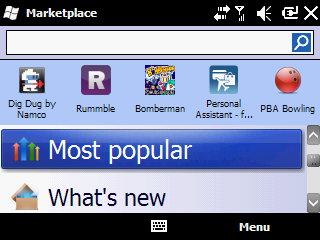
Figure 25: The App Store - Microsoft style. WM 6.5 is the first version that includes the Marketplace, MS' answer to the App Store for the iPhone. It features most of the same options found in their "cross town rival", but far fewer apps at this point and they're quite a bit more expensive in general. Here are a few more notable apps bundled with the Intrepid: - File Explorer;
- YouTube player;
- Sprint TV;
- Remote Desktop;
- Internet Sharing.
Unfortunately, despite the refresh of the interface in general, the only games that the Intrepid includes are the creaky old versions of Solitaire and Bubble Breaker that have been included on Windows Mobile devices for years. Time for an update, guys. ConclusionsGiven that the Intrepid's combination of BlackBerry style and touch screen with WM Professional is new to me, I wasn't quite sure what to expect. But I must say that overall, I liked the Intrepid very much. Though I was most inclined to use it "Windows Mobile Standard" style (using the directional and action keys most of the time in lieu of the touch screen), using the touch screen to scroll while browsing or navigating a long list of contacts is a handy feature. I'm hoping to see a future version of the Intrepid with a higher resolution screen and a stylus that doesn't take an act of a higher power to remove, or even better yet, one with a touch screen design that doesn't require a stylus, but the basics are all there and the Intrepid does an effective job of combining business with pleasure. Doug Raeburn is a Data Architect specializing in Data Warehouse design. He lives in Lannon, WI. 
Do you enjoy using new hardware, software and accessories, then sharing your experience with others? Then join us on the Thoughts Media Review Team! We're looking for individuals who find it fun to test new gear and give their honest opinions about the experience. It's a volunteer role with some great perks. Interested? Then click here for more information. 
|

